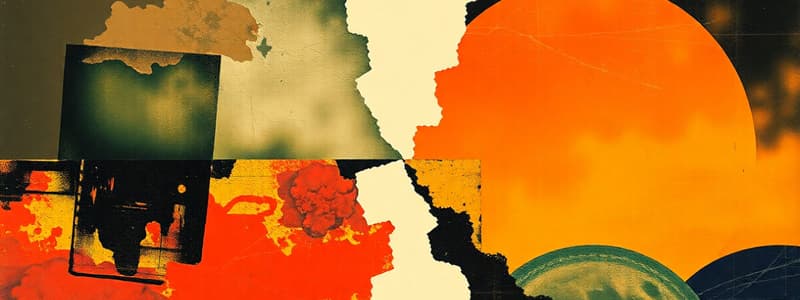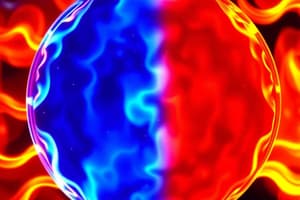Podcast
Questions and Answers
What happens to ice when it gains heat?
What happens to ice when it gains heat?
- It remains unchanged
- It becomes solid water
- It evaporates to become water vapor
- It melts to become liquid water (correct)
At what temperature does water transition from liquid to solid?
At what temperature does water transition from liquid to solid?
- 100°C
- 25°C
- 0°C (correct)
- 50°C
Which factor does NOT affect the rate of evaporation?
Which factor does NOT affect the rate of evaporation?
- Color of the container (correct)
- Wind strength
- Temperature
- Exposed surface area
How is evaporation defined?
How is evaporation defined?
What effect does increasing temperature have on the rate of evaporation?
What effect does increasing temperature have on the rate of evaporation?
How does tepid sponging effectively reduce fever?
How does tepid sponging effectively reduce fever?
What makes mist fans more effective in cooling the surrounding air compared to regular fans?
What makes mist fans more effective in cooling the surrounding air compared to regular fans?
Why does a boy feel colder when he exits the water after swimming?
Why does a boy feel colder when he exits the water after swimming?
What effect does a strong wind have on the sensation of cold after swimming?
What effect does a strong wind have on the sensation of cold after swimming?
How do rooftop gardens contribute to cooling a building?
How do rooftop gardens contribute to cooling a building?
What occurs during the BC section of the graph?
What occurs during the BC section of the graph?
At what temperature does ice begin to melt into water?
At what temperature does ice begin to melt into water?
Which graph section shows a constant temperature despite gaining heat?
Which graph section shows a constant temperature despite gaining heat?
In which section of the graph does water start changing into steam?
In which section of the graph does water start changing into steam?
What is the main characteristic of the CD section of the graph?
What is the main characteristic of the CD section of the graph?
What happens when water reaches its boiling point?
What happens when water reaches its boiling point?
Which statement is true about the AB section of the graph?
Which statement is true about the AB section of the graph?
What is the melting point of ice as indicated in the graph?
What is the melting point of ice as indicated in the graph?
What is the main process by which seawater is transformed into pure water in Alice's experiment?
What is the main process by which seawater is transformed into pure water in Alice's experiment?
Why is a beaker with a smaller opening recommended in the water collection setup?
Why is a beaker with a smaller opening recommended in the water collection setup?
Which method will NOT increase the amount of pure water collected in Alice's setup?
Which method will NOT increase the amount of pure water collected in Alice's setup?
What happens to water vapor as it rises into cooler air in the atmosphere?
What happens to water vapor as it rises into cooler air in the atmosphere?
Which of the following factors primarily affects the rate of evaporation in the setup?
Which of the following factors primarily affects the rate of evaporation in the setup?
What happens during the PQ phase in the cooling process of the water?
What happens during the PQ phase in the cooling process of the water?
At which temperature does water start to freeze?
At which temperature does water start to freeze?
What is true about the QR phase?
What is true about the QR phase?
What occurs during the RS phase?
What occurs during the RS phase?
What characterizes the ST phase of water cooling?
What characterizes the ST phase of water cooling?
How does the state of water change after the TU phase?
How does the state of water change after the TU phase?
Which statement is true about the heat transfer during the cooling of water?
Which statement is true about the heat transfer during the cooling of water?
What can be concluded about the freezing process of water?
What can be concluded about the freezing process of water?
What causes a mirror to become cloudy after a warm shower?
What causes a mirror to become cloudy after a warm shower?
Why do spectacles become misty when leaving an air-conditioned bus?
Why do spectacles become misty when leaving an air-conditioned bus?
What phenomenon causes water droplets to form on the outer surface of a glass of cold drink?
What phenomenon causes water droplets to form on the outer surface of a glass of cold drink?
What explains the formation of water droplets on a car left outdoors overnight?
What explains the formation of water droplets on a car left outdoors overnight?
What creates the 'white mist' observed when breathing out in winter?
What creates the 'white mist' observed when breathing out in winter?
What results in a 'white mist' near the spout of a boiling kettle?
What results in a 'white mist' near the spout of a boiling kettle?
Why does a 'white mist' form around popsicles taken out of the freezer?
Why does a 'white mist' form around popsicles taken out of the freezer?
How do water droplets form on the underside of a lid on a pot of hot soup?
How do water droplets form on the underside of a lid on a pot of hot soup?
What physical process is involved when water vapor condenses on a cold surface?
What physical process is involved when water vapor condenses on a cold surface?
In which scenario do water droplets not form?
In which scenario do water droplets not form?
Flashcards
Water's Solid State
Water's Solid State
Water in its solid form, like ice or snow, at or below 0°C
Evaporation
Evaporation
Liquid water turning into water vapor (gas) at temperatures below boiling point.
Evaporation-Wind
Evaporation-Wind
Strong winds increase the speed of evaporation from a liquid's surface.
Evaporation-Surface Area
Evaporation-Surface Area
Signup and view all the flashcards
Evaporation-Temperature
Evaporation-Temperature
Signup and view all the flashcards
Melting of Ice
Melting of Ice
Signup and view all the flashcards
Melting Point of Ice
Melting Point of Ice
Signup and view all the flashcards
Boiling of Water
Boiling of Water
Signup and view all the flashcards
Boiling Point of Water
Boiling Point of Water
Signup and view all the flashcards
State Change
State Change
Signup and view all the flashcards
Heat Energy
Heat Energy
Signup and view all the flashcards
Temperature Increase (Ice)
Temperature Increase (Ice)
Signup and view all the flashcards
Temperature remains constant (melting)
Temperature remains constant (melting)
Signup and view all the flashcards
Water's Freezing Point
Water's Freezing Point
Signup and view all the flashcards
Water's Liquid State
Water's Liquid State
Signup and view all the flashcards
Temperature Changes (Cooling)
Temperature Changes (Cooling)
Signup and view all the flashcards
Freezing Process
Freezing Process
Signup and view all the flashcards
Constant Temperature During Freezing
Constant Temperature During Freezing
Signup and view all the flashcards
Heat Loss and Temperature
Heat Loss and Temperature
Signup and view all the flashcards
Water Cycle Purpose
Water Cycle Purpose
Signup and view all the flashcards
Evaporation Process
Evaporation Process
Signup and view all the flashcards
Condensation Process
Condensation Process
Signup and view all the flashcards
Seawater Purification
Seawater Purification
Signup and view all the flashcards
Smaller Opening, More Water?
Smaller Opening, More Water?
Signup and view all the flashcards
Tepid Sponging
Tepid Sponging
Signup and view all the flashcards
Mist Fan Cooling
Mist Fan Cooling
Signup and view all the flashcards
Why Swimming Feels Cold Afterward?
Why Swimming Feels Cold Afterward?
Signup and view all the flashcards
Wind & Evaporation
Wind & Evaporation
Signup and view all the flashcards
Rooftop Gardens: Cooling Effect
Rooftop Gardens: Cooling Effect
Signup and view all the flashcards
Condensation
Condensation
Signup and view all the flashcards
What makes a mirror get cloudy?
What makes a mirror get cloudy?
Signup and view all the flashcards
Why do spectacles get misty?
Why do spectacles get misty?
Signup and view all the flashcards
What causes water droplets on a cold drink?
What causes water droplets on a cold drink?
Signup and view all the flashcards
Why is there condensation at night?
Why is there condensation at night?
Signup and view all the flashcards
Why does our breath become a 'white mist' in winter?
Why does our breath become a 'white mist' in winter?
Signup and view all the flashcards
How does a boiling kettle create mist?
How does a boiling kettle create mist?
Signup and view all the flashcards
Why do popsicles create mist?
Why do popsicles create mist?
Signup and view all the flashcards
Why does water collect under a hot soup lid?
Why does water collect under a hot soup lid?
Signup and view all the flashcards
What is the key factor in condensation?
What is the key factor in condensation?
Signup and view all the flashcards




